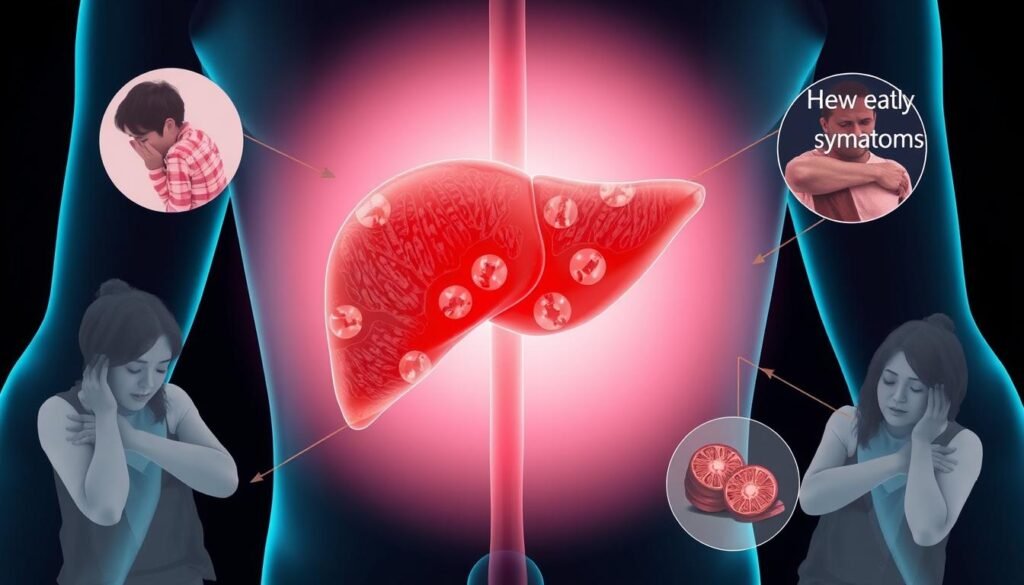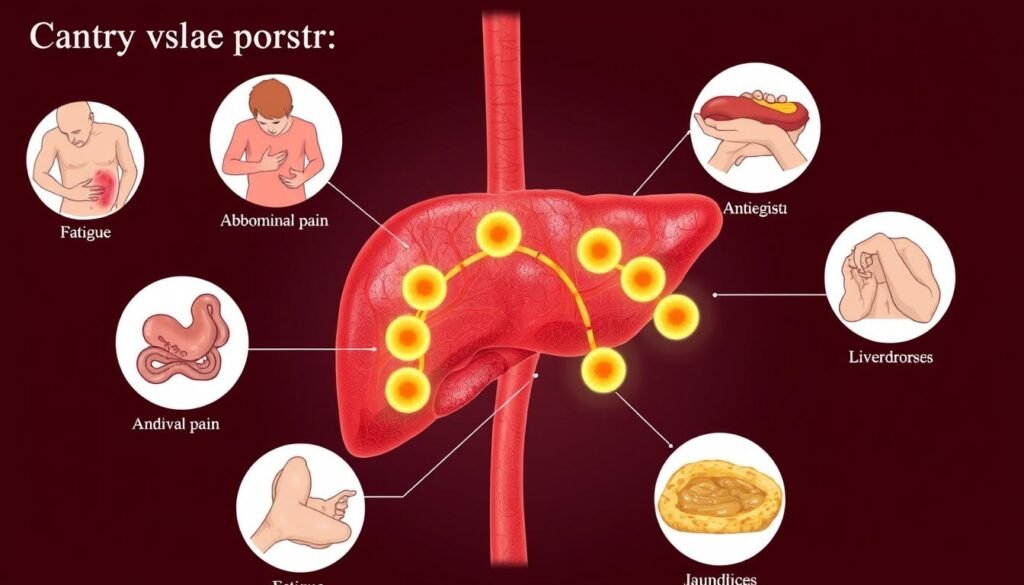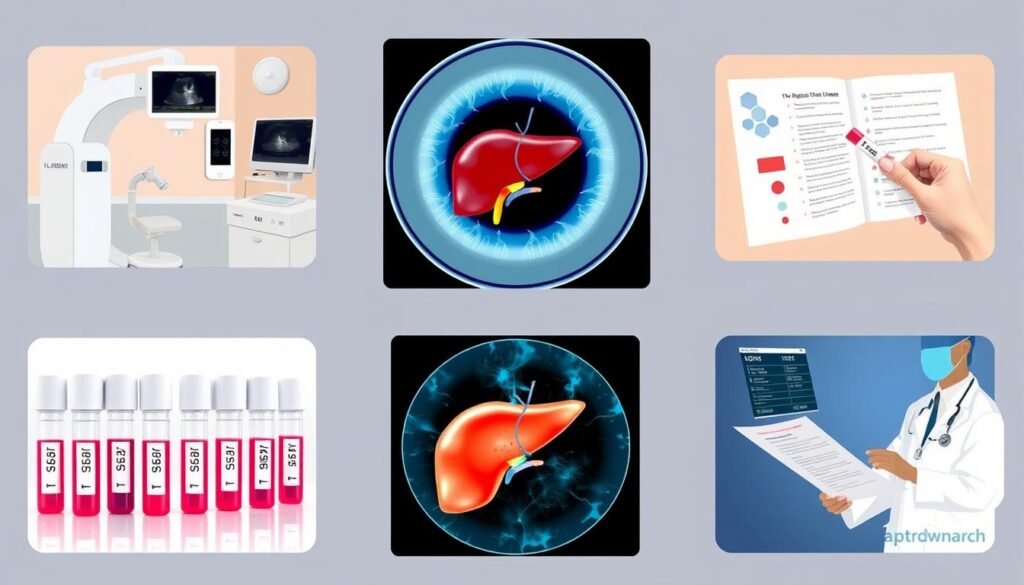About 25% of U.S. adults have fatty liver disease. Yet, many don’t know its symptoms. These symptoms can turn into big health problems if not treated. It’s important to know the early signs of liver disease. This way, you can catch it early and get better faster. We’ll talk about the signs of fatty liver that people often miss. We want you to take care of your liver health early on.
Key Takeaways
- Fatty liver disease affects about 25% of adults in the U.S.
- Recognizing symptoms early can prevent serious health issues.
- Common symptoms include fatigue, abdominal discomfort, and weight changes.
- Consulting a healthcare professional is key for accurate diagnosis.
- Awareness and education are critical for managing liver health.
Understanding Fatty Liver Disease
Fatty Liver Disease (FLD) has two main types: alcoholic (AFLD) and non-alcoholic (NAFLD). While AFLD is due to too much alcohol, NAFLD happens mostly in those who drink little or no alcohol. Being overweight, having diabetes, or metabolic syndrome are big factors for NAFLD.
The liver helps detoxify our body and manage our metabolism. If too much fat accumulates, it can cause inflammation or worse, like cirrhosis or cancer. Spotting signs of liver disease early is key to managing it well. Symptoms to watch for include feeling tired, belly discomfort, and swelling, signaling severe liver issues.
To prevent Fatty Liver Disease, lifestyle changes are critical. Eating right, staying active, and drinking less alcohol can make a big difference. For more info on symptoms and causes, check out Understanding Fatty Liver Disease.
Common Symptoms of Fatty Liver Disease
Fatty liver disease comes with several symptoms. Knowing them helps people catch problems early. It’s crucial to recognize signs and get doctor’s advice when needed. Symptoms differ from person to person. Some might feel mild discomfort, others face bigger issues.
Physical Symptoms
Common physical symptoms linked to fatty liver disease include:
- Fatigue: Many mention feeling constantly tired or having low energy.
- Abdominal pain: There’s often pain in the upper right side of the belly.
- Loss of appetite: There can be a significant drop in wanting to eat.
- Weight loss: Some may notice they’re losing weight without trying.
Even if no symptoms show at first, it’s vital to have regular doctor visits. Being aware of fatty liver symptoms leads to better health care and timely help.
Spotting these symptoms early makes getting the right medical help easier. Knowing what these signs mean is key for liver health and staying well.
Signs of Liver Disease in the Early Stages
Noticing early signs of liver disease is key to keeping your liver healthy. While symptoms can differ, there are some common warnings. One of the first signs is jaundice, where the skin and eyes turn yellow. This happens due to too much bilirubin in the body because the liver can’t process it well.
Another telling sign is dark urine. If the liver isn’t working right, bilirubin makes urine darker. Also, some people might feel itchy skin. This itchiness comes from bile salts building up under the skin. It’s a signal that the liver might be getting worse.
It’s crucial to pay attention to these liver disease signs early on. Spotting these symptoms early can help manage the condition better. This leads to improved health.
Fatty Liver Symptoms List: Key Indicators
It’s key to know the signs of fatty liver disease to keep your liver healthy. The fatty liver symptoms list includes many signs to watch out for. How bad these symptoms are can vary. It helps to know which are the most common.
Next, we’ll look at symptoms that are common, less seen, and very serious.
- Common Symptoms:
- Fatigue
- Weakness
- Weight loss
- Abdominal discomfort
- Less Common Symptoms:
- Elevated liver enzymes
- Jaundice (yellowing of the skin and eyes)
- Swelling in the abdomen (ascites)
- Serious Symptoms:
- Confusion or altered mental state
- Severe abdominal pain
- Bleeding or bruising easily
Knowing these liver disease symptoms can lead to early diagnosis and better health management. The fatty liver symptoms list is a tool to help you take charge of your health and wellness.
| Symptom Category | Examples | Severity |
|---|---|---|
| Common Symptoms | Fatigue, Weakness | Moderate |
| Less Common Symptoms | Elevated liver enzymes, Jaundice | High |
| Serious Symptoms | Severe abdominal pain, Confusion | Critical |
Recognizing Fatty Liver Symptoms
Fatty liver symptoms are key for good health. Many may not see the early warning signs of liver issues. Spotting these signs early means fewer complications later. It’s important to check your health often. This helps catch liver problems before they get worse.
Here are some common symptoms:
- Unexplained fatigue
- Weight gain, particularly around the abdominal area
- Changes in appetite, including increased hunger or early satiety
- Abdominal discomfort or pain
- Yellowing of the skin or eyes (jaundice)
Tracking your health is crucial for spotting liver disease signs. Eating well and staying active helps avoid fatty liver issues. If you notice anything strange, talk to a doctor right away. Quick action can make a huge difference.
Exploring Fatty Liver Signs
Many people know the common signs of liver disease. But looking into fatty liver signs shows more symptoms. Mood changes, memory issues, and feeling tired can warn us about liver problems early.
Having metabolic syndrome might link to fatty liver disease. If you’re gaining weight, have high blood pressure, or weird cholesterol levels, take note. These signs could show in different ways. Also, if your stomach often feels bad, it might mean your liver is not working right.
Knowing how these signs connect helps us find liver issues early. This also shows how important liver health is to feeling good overall. Mood swings or trouble focusing are easy to miss. Yet, they are important hints of liver trouble.

The Importance of Early Diagnosis
Early diagnosis is key in tackling fatty liver disease. Recognizing it early can greatly improve treatment success. If not caught in time, the disease can progress to serious conditions like cirrhosis or liver cancer.
Lifestyle changes can reverse fatty liver effects if caught early. By eating healthier, exercising more, and managing weight, individuals can boost their liver health. Early diagnosis allows people to act before the damage is too great.
Regular liver checks are essential, especially for those at higher risk. This includes people with obesity, diabetes, or those who drink alcohol. Early detection leads to easier and more effective treatment. Realizing the value of early diagnosis can improve outcomes and lower health care costs from advanced liver diseases.
| Factor | Impact of Early Diagnosis | Consequences of Late Diagnosis |
|---|---|---|
| Lifestyle Changes | Reversal of fatty liver possible | Increased risk of cirrhosis |
| Medical Interventions | More effective when initiated early | Reduced treatment options |
| Healthcare Costs | Lower overall costs with early management | Higher costs due to advanced disease management |
| Patient Outcomes | Improved long-term health prospects | Increased morbidity and mortality rates |
Liver Disease Symptoms by Type of Fatty Liver Disease
Fatty liver disease comes in two forms: Alcoholic Fatty Liver Disease (AFLD) and Non-Alcoholic Fatty Liver Disease (NAFLD). Each has its own symptoms, which are key for getting help.
AFLD is caused by too much alcohol. It makes the liver inflamed and damaged. Symptoms include:
- Jaundice (yellowing of skin and eyes)
- Abdominal swelling
- Nausea and vomiting
- Fatigue
NAFLD happens in those who hardly drink. It’s often seen with obesity, diabetes, or metabolic syndrome. Symptoms of NAFLD are:
- Unexplained fatigue
- Discomfort in the upper right abdomen
- Insulin resistance
- Elevated liver enzymes in blood tests

Differences in these diseases show in how they affect the liver. AFLD directly harms the liver through alcohol. NAFLD links to the body’s metabolic issues. Knowing the type helps you seek help faster.
| Type of Fatty Liver Disease | Liver Disease Symptoms |
|---|---|
| AFLD | Jaundice, Abdominal swelling, Nausea, Fatigue |
| NAFLD | Fatigue, Abdominal discomfort, Insulin resistance, Elevated liver enzymes |
When to Seek Medical Advice for Fatty Liver Symptoms
It’s key to know when to see a doctor for fatty liver symptoms. If you have ongoing pain in the upper right abdomen, feel unusually tired, or notice big changes in your weight, get medical help right away. Not acting on these signs can make things worse.
Some symptoms mean you should seek help immediately:
- Jaundice (yellowing of the skin and eyes)
- Swelling in the abdomen or legs
- Severe nausea or vomiting
- Confusion or cognitive changes
- Dark urine or pale stool
When you talk to your doctor, be clear about what you’re feeling. Being open and honest helps them understand what’s going on. Keep talking to your doctor about any new or ongoing symptoms. Going for regular check-ups helps keep track of the condition.
Getting medical advice early for fatty liver symptoms is crucial. Proactive health management can stop further damage to your liver.
Diagnostic Methods for Fatty Liver Disease
Getting a correct fatty liver diagnosis requires multiple tests. Doctors use various methods to check liver health and fat levels.
Imaging tests are crucial. Ultrasounds, which are safe and non-invasive, help spot fat in the liver. CT scans provide a closer look, showing the liver’s structure and fat. MRIs offer detailed images for precise fatty infiltration evaluation.
Blood tests are equally important. They check liver enzymes, cholesterol, and blood sugar. These tests give insights into liver health and metabolism. They might show if there’s liver damage or inflammation.
For in-depth analysis, a liver biopsy might be needed. It involves removing a tiny piece of liver tissue. This is then examined to identify fat, inflammation, or scarring.
This mix of methods allows doctors to create effective treatment plans. Regular checks help track the disease’s progress.
For more information on diagnostic methods for fatty liver disease, please see a healthcare expert.

Conclusion
Knowing the signs of fatty liver disease helps keep your liver healthy. Finding it early leads to better care and might reverse it. It’s vital to notice early liver disease signs. Feelings of tiredness, upper right belly discomfort, and losing weight without trying should be taken seriously.
Taking care of your health and talking to a doctor when you see these signs is important. Knowing what signs to look for gives you power. It lets you talk well with your doctor about your health.
The key is being aware and acting on time. Paying attention to fatty liver disease symptoms improves early diagnosis and treatment chances. This can make your health better overall.